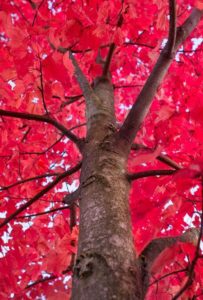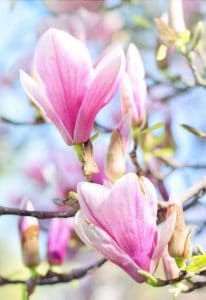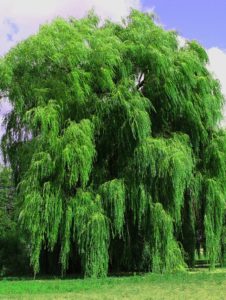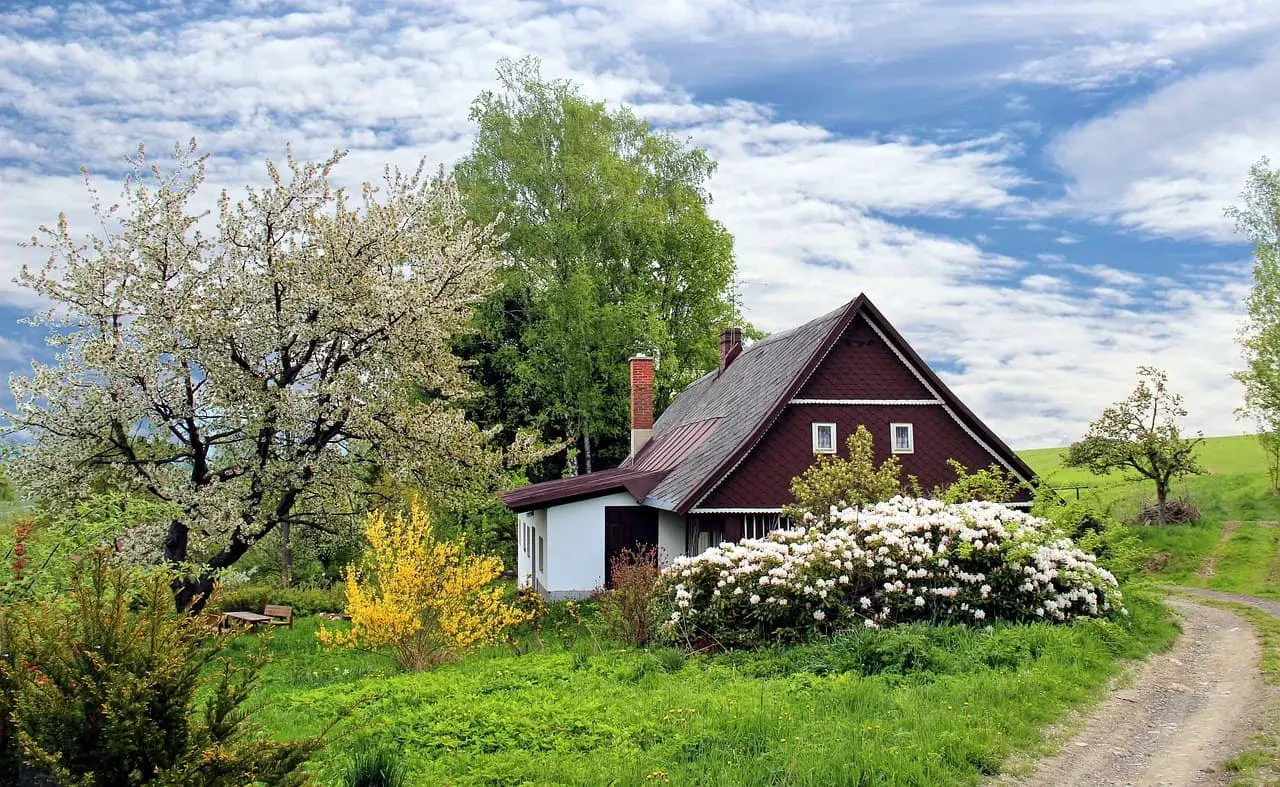Some links in the post are affiliate links and I get a commission from purchases made through some links found in the post.
Don’t you love the springtime! I certainly do. It’s a time to plant. Anyone who has even remote green fingers and thumbs likes to get into the garden and see things grow.
From flowers and vegetables to shrubs and trees, spring is the time to plan your summer garden.
When we plan on adding trees there are some things that we need to remember. Possibly the main one is the root system of the tree.
Trees are a little like icebergs in the ocean. We only see the top part but underneath there is a whole different world, deep and sprawling, looking for food and water wherever it can be found.
Our finca in Spain has a septic tank system and when I plant anything near it, I always need to be thinking about the root system.
Replacing a tree is easy and cheap compared to repairing a septic tank!
Two Types of Roots
Trees come with two types of root systems. These are the tap root system and the adventitious root system.
Tap roots will grow straight down vertically while an adventitious root system will spread and sprawl.
If you were to see underground you would see that tap roots have a long, straight root with many smaller roots growing out to the sides.
Opposite to this is the fibrous or adventitious root system where the bulk of the root is near the surface of the soil.
Here you will see a dense network of roots all spreading outwards in the ongoing quest for nutrients.
Plants that are found in arid conditions tend to have deep root systems, unlike plants that grow where water is more freely available and have a shallow root system.
So, when we plan on adding a tree, the root system should be one of the main points to consider.
Non invasive roots are those that go deep down instead of out towards your septic tank or house in search of water.
Top 5 Small Trees with Non Invasive Rroots
 There are several trees which are classed as having non invasive roots; Japanese maple, dwarf korean lilac, magnolia, crabapples and kousa dogwood.
There are several trees which are classed as having non invasive roots; Japanese maple, dwarf korean lilac, magnolia, crabapples and kousa dogwood.
Fast growth for a tree is described as growing more than 36 inches per year so this is something to bear in mind when you choose your ‘small’ tree.
Small trees with non invasive roots can be safely placed close to patios, walls, and houses without the fear of the roots growing towards them.
One bonus of small trees with non invasive roots is that they tend to be sturdy with less likelihood of them falling over and crushing your garden or fence in high winds.
Ornamental small trees with non invasive root systems are the perfect solution for beautiful gardens. Ornamentals grow to a manageable height and can even be grown in planters.
They fit into smaller spaces and are easy to maintain and keep to a shape you like.
1) Japanese Maple
The japanese maple is perfect for small places and also do well in containers.
They come in several different leaf colours ranging from orange, green, red, and purple as well as a variegated variety.
Check out his article on where should you plant a Japanese maple tree.
2) Dwarf Korean Lilac
This is an unusual tree which will give you lilac to reddish purple blooms and small dark green leaves.
The tree will bloom profusely in the spring and have a delicate fragrance as soon as the buds start to open.
3) Magnolia
This is also called Star Magnolia and has large white flowers which develop even before the leaves have uncurled.
4) Crabapples
These are very popular as ornamental trees because they bloom so early in the spring.
They also stay quite small even as mature trees. Look for Red Jewel and Royal Raindrops.
5) Kousa Dogwood
You may also have heard this called Japanese Strawberry tree or Chinese Dogwood. It is a slow-growing tree, only managing 12”-24” per year.
What is great about this tree is the number of flowers that appear in the spring, typically people plant it for this reason.
Top Fruit Trees with Non Invasive Roots
There are several fruit trees which are classed as having non invasive roots.
Not only will they look pretty and supply you with fruit, but you can rest assured that the roots will not head for your water pipes or septic tank system.
A point to remember here is that if you prune the tree to a manageable size the roots will adapt to the size and not extend too far.
- Dwarf cherry
- Dwarf pear
- Pawpaw
- Dwarf orange
- Dwarf plum
- Citrus trees
- Dwarf apple
- Dwarf apricot
One of the worst fruit trees to plant if you are looking for non invasive roots is the fig tree.
If your heart is set on one of these, make sure you can plant it a good length away from house, swimming pool, hot tub, and septic tank system as it is a glutton for water and the roots will entangle with any source of water it can find.
Top Evergreen Trees with Non Invasive Roots
 One thing to remember for trees with fibrous, shallow roots (non invasive) is that they need good drainage so be sure to check this before you plant.
One thing to remember for trees with fibrous, shallow roots (non invasive) is that they need good drainage so be sure to check this before you plant.
- Native Frangipani
- Illwarra Flame Tree
- Olive tree
- Paulownia
- English Holly
- Australian Willow
- Bronze Loquat
- Rhododendron
You may be interested in an article we have written on what are the fastest growing evergreen trees for small gardens.
Plants That are Safe for Septic Tanks
Just because I know how paranoid I was when I first wanted to plant anything near the septic tank area, I am going to add a selection that will not damage anything here.
Because you have a septic tank, it does not mean you should avoid planting anything there.
On the contrary, you should get some plant life there to prevent erosion. Plants will also absorb moisture from the drain away area.
Grasses and perennials work well in these areas because they have shallow roots. Creeping Charlie works well as do Jewelweed plants.
You should not grow any plants around the drain area that you plan to eat as there is a chance of ingesting harmful bacteria so avoid making your vegetable garden in that area.
Some Trees that are Suitable for the Septic Area
Japanese maple
These trees look great all year round. The stem of the tree changes colour with the seasons and the leaves develop into yellow/gold with pink tips.
Cherry
Cherry trees need well-drained soil. Fertile soils will keep them happy. One thing they do not like is to be crowded by other trees.
They enjoy sunlight and you should have them where they receive eight hours of sunlight a day.
Azalea shrubs
Once they start to flower in the spring you will find that they carry on for several months.
They tolerate the shade and like to be placed close to other trees, or even underneath them.
Holly
The species includes evergreen, deciduous, shrubs and climbers, all of which can handle temperatures from tropical to temperate.
Boxwood
Common Boxwood will grow into a round shape. It is evergreen and you may often see it on rocky hillsides.
Boxwood makes a great hedge and border and is also widely used for topiary.
Dogwood
This tree makes a great ornamental addition to any garden. They need plenty of water and if you meet this condition they will be happy.
And These are the Worst..
- Weeping willow
- Aspen
- Birch
- Elm
- Pussywillow
- Maple trees other than the Japanese maple
- Ash
- Fig
These trees do not care where they get their water from, they will head right for it and make aggressive moves to find nutrients.
They are not fussy feeders and are notorious for ruining many a septic tank!
Generally, you should plant your tree as many feet away from the tank as the tree is tall.
Example: if your tree will be 30’ tall at maturity, them aim to plant it 30’ away from the tank.
If you absolutely cannot provide that amount of space then you many want to install a barrier to restrict the roots as they grow.
Final Thoughts: Top 5 Best Small Trees with Non Invasive Roots
 If you are planning the front garden for a new house, or even if you have moved into a new home and want to add plants to the garden, it is always worth thinking about the size that the new plant will reach.
If you are planning the front garden for a new house, or even if you have moved into a new home and want to add plants to the garden, it is always worth thinking about the size that the new plant will reach.
In years to come it would be a waste to have to chop down a tree because it has grown so large and blocked out all the light in a room.
All garden centres should be able to tell you the full size a plant will reach.
Equally important is the root structure because the last thing you need is to have to relay a path after roots have cracked it.
More importantly you do not need invasive roots anywhere near your house, the sewer, or a septic system.
Choose your plants with non invasive roots if there is anything in the vicinity that they can grow towards and damage. Never underestimate the power of roots in search of water and nutrients.
With some forethought and planning, there is no reason why you should not have one of the best small trees with non invasive roots exactly where you want it.
Written by: Valerie Holyoak
Before you go, here are some more related articles I encourage you to read below to help solve more of your gardening issues:
What are the Best Trees to Plant Near Your House for Shade


